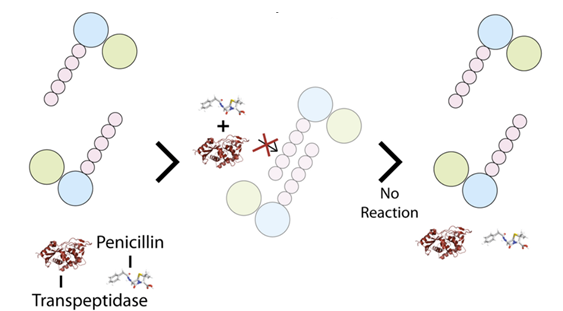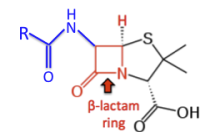Medical Pharmacology Chapter 35 Antibacterial Drugs
Penicillins
β-Lactamase Inhibitors (Introduction to Penicillins)
Penicillins are class of antibiotics that act by interfering with bacterial cell wall synthesis.1,2
These antibiotics inhibit peptidoglycan formation, structural essentials of bacterial cell walls.
 |
|
Inhibition occurs because penicillins resemble part of the peptide precursor normally recognized by transpeptidases (also known as penicillin-binding proteins or PBPs).
Transpeptidases are responsible for catalyzing cross-linking of peptidoglycan chains.
Cross-linking these chains provide both stability and rigidity to the bacterial cell wall.
Penicillin-binding to the active site of transpeptidases prevents this cross-linking process by irreversibly inactivating the enzymes.
Because of this inactivation, the weekend and unstable bacterial cell wall will lack the structural integrity needed to withstand osmotic pressure and as result eventually lyse.
![]() Beta-lactamases
are bacterial enzymes that confer resistance to ß-lactam
antibiotics, such as penicillins.
Beta-lactamases
are bacterial enzymes that confer resistance to ß-lactam
antibiotics, such as penicillins.
The beta-lactamases work by hydrolyzing the ß-lactam ring which is critical structural element present in all penicillins and related antibiotics such as carbapenems and cephalosporins.
 |
|
Cleavage of the ß-lactam ring results in an inactive penicillin molecule since it can no longer bind in inhibit transpeptidase enzymes.
![]() This
enzymatic inactivation represents the primary mechanism
by which bacterial resistance to penicillin antibiotics
develops.
This
enzymatic inactivation represents the primary mechanism
by which bacterial resistance to penicillin antibiotics
develops.
Genes encoding ß-lactamases are found on bacterial plasmids, mobile genetic elements easily transferable between bacteria.
This "horizontal" gene transfer contributes to the rapid spread of antibiotic resistance in bacteria populations.
![]() In
order to overcome this resistance mechanism, some penicillin
formulations include ß-lactamase inhibitors that bind to and
inactivate ß-lactamase enzymes, consequently protecting
coadministered penicillin.
In
order to overcome this resistance mechanism, some penicillin
formulations include ß-lactamase inhibitors that bind to and
inactivate ß-lactamase enzymes, consequently protecting
coadministered penicillin.
August, 2025
|
|
This Web-based pharmacology and disease-based integrated teaching site is based on reference materials, that are believed reliable and consistent with standards accepted at the time of development. Possibility of human error and on-going research and development in medical sciences do not allow assurance that the information contained herein is in every respect accurate or complete. Users should confirm the information contained herein with other sources. This site should only be considered as a teaching aid for undergraduate and graduate biomedical education and is intended only as a teaching site. Information contained here should not be used for patient management and should not be used as a substitute for consultation with practicing medical professionals. Users of this website should check the product information sheet included in the package of any drug they plan to administer to be certain that the information contained in this site is accurate and that changes have not been made in the recommended dose or in the contraindications for administration. Advertisements that appear on this site are not reviewed for content accuracy and it is the responsibility of users of this website to make individual assessments concerning this information. Medical or other information thus obtained should not be used as a substitute for consultation with practicing medical or scientific or other professionals. |